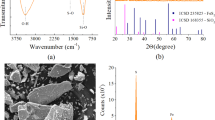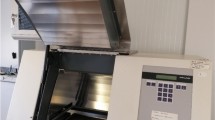Abstract
Anti-inflammatories are drugs that currently can be found in effluents and, as a consequence, in surface and groundwater. Therefore, this work aimed to evaluate the efficiency of advanced oxidative processes in the degradation of the drugs ketoprofen, tenoxicam and meloxicam, aiming application in wastewater treatment. The system studied was photo-Fenton peroxidation under artificial sunlight radiation (iron source: ferrous sulfate or steel wool residue). The working conditions for the system with residue were 1.25 and 300 mg·L−1 of ferrous and oxidant, and pH ≈ 2.5. The degradation kinetics was monitored by ultraviolet visible spectrophotometer and the experimental data by it represented by the model of by Nichela and collaborators. After 90 min, the systems achieved a degradation greater than 82%, monitoring the wavelength of 260 nm, and greater than 96%, at 367 nm. In synthetic effluent, the chemical oxygen demand was reduced by 89% after 270 min, obtaining a good fit to Nichela and collaborators model. Through liquid chromatography and toxicity tests (it was verified the degradation of the original compounds and formation of more toxic intermediates, in relation to the aqueous solution. Analisando de forma conjunta dos dados das análises cromatográficas com os testes de toxicidade, utilizando moluscos, verificou-se a degradação dos compostos originais, com formação de intermediários. Seeking a way to reduce toxicity, considering the results obtained for the artificial solar radiation, the use of the natural one is proposed due to its high availability that combined with the use of waste reduces the costs of the process, making it a viable alternative for treating contaminated water.








Similar content being viewed by others
Data availability
The authors declare that the data supporting the findings of this study are available within the paper and its supplementary information files.
References
APHA (2012) Standard methods for the examination of water and wastewater, 22nd edn. American Public Health Association, Washington
Audino F, Conte L, Schenone A, Pérez-Moya M, Graells M, Alfano OM (2017) A kinetic study for the Fenton and photo-Fenton paracetamol degradation in a pilot plant reactor. Comput Aided Chem Eng 40:301–306. https://doi.org/10.1016/B978-0-444-63965-3.50052-0
Barros Neto B, Scarminio IS, Bruns RE (2007) Como fazer experimentos: pesquisa e desenvolvimento na ciência e na indústria. Editora da Unicamp, Campinas
Comber S, Gardner M, Sörme P, Leverett D, Ellor B (2018) Active pharmaceutical ingredients entering the aquatic environment from wastewater treatment works: a cause for concern? Sci Total Environ 613–614:538–547. https://doi.org/10.1016/j.scitotenv.2017.09.101
Dutta A, Chakraborty I, Sarkar D, Chakrabarti S (2015) Sunlight-assisted photo-Fenton degradation of pesticide in wastewater: ecotoxicological impact on Nostoc sp Algae. Water Air Soil Pollut 226:1–13. https://doi.org/10.1007/s11270-015-2661-6
European Commision (2017) Options for a strategic approach to pharmaceuticals in the environment. Ref. Ares, 2210630–28/04/2017
European Commision (2019) European Union Strategic Approach to Pharmaceuticals in the Environment. EC, Brussels, Belgium
Evgenidou E, Chatzisalata Z, Tsevis A, Bourikas K, Torounidou P, Sergelidis D, Koltsakidou A, Lambropoulou DA (2021) Photocatalytic degradation of a mixture of eight antibiotics using Cu-modified TiO2 photocatalysts: Kinetics, mineralization, antimicrobial activity elimination and disinfection. J Environ Chem Eng 9:105295. https://doi.org/10.1016/j.jece.2021.105295
Farias F, Martins VAP, Yano HM, Trujillo LM, Pinto E (2021) Forced degradation studies to identify organic impurities in pharmaceuticals: a Brazilian perspective. Rev Ciênc Farm Básica Apl 42:729. https://doi.org/10.4322/2179-443X.07291/13
Fioreze M, Santos EP, Schmachtenberg N (2014) Processos oxidativos avançados: fundamentos e aplicação ambiental. Rev Eletrônica Em Gestão, Educ e Tecnol Ambient 18:79–91. https://doi.org/10.5902/2236117010662
He Y, Sutton NB, Rijnaarts HHH, Langenhoff AAM (2016) Degradation of pharmaceuticals in wastewater using immobilized TiO2 photocatalysis under simulated solar irradiation. Appl Catal B Environ 182:132–141. https://doi.org/10.1016/j.apcatb.2015.09.015
He BS, Wang J, Liu J, Hu XM (2017) Eco-pharmacovigilance of non-steroidal anti-inflammatory drugs: necessity and opportunities. Chemosphere 181:178–189. https://doi.org/10.1016/j.chemosphere.2017.04.084
Hykrdová L, Bajt O, Jirkovský J (2018) Mechanism and kinetics of photochemical transformation of ketoprofen and its degradation intermediates. J Hazard Mater 353:70–79. https://doi.org/10.1016/j.jhazmat.2018.03.048
Ike IA, Orbell JD, Duke M (2018) Steel wool and carbonyl iron powder activation of persulphate for the degradation of pollutants. J Water Process Eng 25:58–69. https://doi.org/10.1016/j.jwpe.2018.06.010
Iqbal J, Shah NS, Khan ZUH, Rizwan M, Murtaza B, Jamil F, Shah A, Ullah A, Nazzal Y, Howari F (2022a) Visible light driven doped CeO2 for the treatment of pharmaceuticals in wastewater: a review. J Water Process Eng 49:103130. https://doi.org/10.1016/j.jwpe.2022.103130
Iqbal J, Shah NS, Sayed M, Rauf S, Khan ZUH, Niazi NK, Polychronopoulou K, Howari F, Rehman F (2022b) Efficient removal of norfloxacin using nano zerovalent cerium composite biochar-catalyzed peroxydisulfate. J Clean Prod 377:134405. https://doi.org/10.1016/j.jclepro.2022.134405
Jiménez JJ, Muñoz BE, Sánchez MI, Pardo R (2018) Forced and long-term degradation assays of tenoxicam, piroxicam and meloxicam in river water. Degradation products and adsorption to sediment. Chemosphere 191:903–910. https://doi.org/10.1016/j.chemosphere.2017.10.056
Khennaoui B, Malouki MA, López MC, Zehani F, Boutaoui N, Salah ZR, Zertal A (2017) Heterogeneous photo-Fenton process for degradation of azo dye: Methyl orange using a local cheap material as a photocatalyst under solar light irradiation. Optik (stuttg) 137:6–16. https://doi.org/10.1016/j.ijleo.2017.02.081
Lai WWP, Lin YC, Tung HH, Lo SL, Lin AYC (2016) Occurrence of pharmaceuticals and perfluorinated compounds and evaluation of the availability of reclaimed water in Kinmen. Emerg Contam 2:135–144. https://doi.org/10.1016/j.emcon.2016.05.001
Lima LB, Pereira LO, Moura SG, Magalhães F (2017) Degradation of organic contaminants in effluents—synthetic and from the textile industry—by Fenton, photocatalysis, and H2O2 photolysis. Environ Sci Pollut Res 24:6299–6306. https://doi.org/10.1007/s11356-016-6973-x
Lima MV, Siqueira WN, Silva HAMF, Lima Filho JM, França EJ, Melo AMMA (2019) Cytotoxic and genotoxic effect of oxyfluorfen on hemocytes of Biomphalaria glabrata. Environ Sci Pollut Res 26(4):3350–3356. https://doi.org/10.1007/s11356-018-3848-3
Marsik P, Rezek J, Židková M, Kramulová B, Tauchen J, Vaněk T (2017) Non-steroidal anti-inflammatory drugs in the watercourses of Elbe basin in Czech Republic. Chemosphere 171:97–105. https://doi.org/10.1016/j.chemosphere.2016.12.055
Martínez C, Vilariño S, Fernández MI, Faria J, Canle ML, Santaballa JA (2013) Mechanism of degradation of ketoprofen by heterogeneous photocatalysis in aqueous solution. Appl Catal B Environ 142–143:633–646. https://doi.org/10.1016/j.apcatb.2013.05.018
Mirzaei A, Chen Z, Haghighat F, Yerushalmi L (2017) Removal of pharmaceuticals from water by homo/heterogonous Fenton-type processes—a review. Chemosphere 174:665–688. https://doi.org/10.1016/j.chemosphere.2017.02.019
Moura MMMS, Lucena ALA, Napoleão DC, Duarte MMMB, Lima VE, de Melo Neto AA (2021) Degradation of the mixture of the ketoprofen, meloxicam and tenoxicam drugs using TiO2/metal photocatalysers supported in polystyrene packaging waste. Water Sci Technol 83:863–876. https://doi.org/10.2166/wst.2021.025
Napoleão DC, Zaidan LEMC, Santana RMR (2018) Use of the photo-Fenton process to discover the degradation of drugs present in water from the wastewater treatment plants of the pharmaceutical industry. Afinidad 75:19–27
Nichela D, Haddou M, Benoit-Marquié F, Maurette MT, Oliveros E, García Einschlag FS (2010) Degradation kinetics of hydroxy and hydroxynitro derivatives of benzoic acid by Fenton-like and photo-Fenton techniques: a comparative study. Appl Catal B Environ 98:171–179. https://doi.org/10.1016/j.apcatb.2010.05.026
Nippes RP, Macruz PD, Neves Olsen Scaliante MH (2021) Toxicity reduction of persistent pollutants through the photo-Fenton process and radiation/H2O2 using different sources of radiation and neutral pH. J Environ Manage 289:112500. https://doi.org/10.1016/j.jenvman.2021.112500
Paíga P, Delerue-Matos C (2016) Determination of pharmaceuticals in groundwater collected in five cemeteries’ areas (Portugal). Sci Total Environ 569–570:16–22. https://doi.org/10.1016/j.scitotenv.2016.06.090
Rayaroth MP, Aravindakumar CT, Shah NS, Boczkaj G (2022) Advanced oxidation processes (AOPs) based wastewater treatment - unexpected nitration side reactions—a serious environmental issue: a review. J Chem Eng 430:133002. https://doi.org/10.1016/j.cej.2021.133002
Rozas O, Vidal C, Baeza C, Jardim WF, Rossner A, Mansilla HD (2016) Organic micropollutants (OMPs) in natural waters: oxidation by UV/H2O2 treatment and toxicity assessment. Water Res 98:109–118. https://doi.org/10.1016/j.watres.2016.03.069
Salgado R, Pereira VJ, Carvalho G, Soeiro R, Gaffney V, Almeida C, Cardoso VV, Ferreira E, Benoliel MJ, Ternes TA, Oehmen A, Reis MAM, Noronha JP (2013) Photodegradation kinetics and transformation products of ketoprofen, diclofenac and atenolol in pure water and treated wastewater. J Hazard Mater 244–245:516–527. https://doi.org/10.1016/j.jhazmat.2012.10.039
Santos MMM, Duarte MMMB, Nascimento GE, Souza NBG, Rocha ORS (2019) Use of TiO2 photocatalyst supported on residues of polystyrene packaging and its applicability on the removal of food dyes. Environ Technol (UK) 40:1494–1507. https://doi.org/10.1080/09593330.2017.1423396
Santos MMM, Silva TD, Lucena ALA, Napoleão DC, Duarte MMMB (2020) Degradation of ketoprofen, tenoxicam, and meloxicam drugs by photo-assisted peroxidation and photo-Fenton processes: identification of intermediates and toxicity study. Water Air Soil Pollut. https://doi.org/10.1007/s11270-020-4401-9
Santos-Juanes L, García-Ballesteros S, Vercher RF, Amat AM, Arques A (2019) Commercial steel wool used for Zero Valent Iron and as a source of dissolved iron in a combined red-ox process for pentachlorophenol degradation in tap water. Catal Today 328:252–258. https://doi.org/10.1016/j.cattod.2019.01.007
Segura Y, Cruz-del-Álamo A, Munoz M, Álvarez-Torrellas S, García J, Casas JA, De Pedro ZM, Martínez F (2021) A comparative study among catalytic wet air oxidation, Fenton, and Photo-Fenton technologies for the on-site treatment of hospital wastewater. J Environ Manag. https://doi.org/10.1016/j.jenvman.2021.112624
Serpone N, Artemev YM, Ryabchuk VK, Emeline AV, Horikoshi S (2017) Light-driven advanced oxidation processes in the disposal of emerging pharmaceutical contaminants in aqueous media: a brief review. Curr Opin Green Sustain Chem 6:18–33. https://doi.org/10.1016/j.cogsc.2017.05.003
Shah NS, Khan JA, Sayed M, Khan ZUH, Rizwan AD, Muhammad N, Boczkaj G, Murtaza B, Imran M, Khan HM, Zaman G (2018) Solar light driven degradation of norfloxacin using as-synthesized Bi3+ and Fe2+ co-doped ZnO with the addition of HSO5−: toxicities and degradation pathways investigation. J Chem Eng 351:841–855. https://doi.org/10.1016/j.cej.2018.06.111
Shah NS, Khan JA, Sayed M, Khan ZUH, Ali HS, Murtaza B, Khan HM, Imran M, Muhammad N (2019) Hydroxyl and sulfate radical mediated degradation of ciprofloxacin using nano zerovalent manganese catalyzed S2O82−. J Chem Eng 356:199–209. https://doi.org/10.1016/j.cej.2018.09.009
Shankaraiah G, Saritha P, Bhagawan D, Himabindu V, Vidyavathi S (2017) Photochemical oxidation of antibiotic gemifloxacin in aqueous solutions—a comparative study. S Afr J Chem Eng 24:8–16. https://doi.org/10.1016/j.sajce.2017.06.002
Sinhmar A, Setia H, Kumar V, Sobti A, Toor AP (2020) Enhanced photocatalytic activity of nickel and nitrogen codoped TiO2 under sunlight. Environ Technol Innov 18:100658. https://doi.org/10.1016/j.eti.2020.100658
Siqueira WN, França EJ, Pereira DR, Lima MV, Silva HAMF, Araújo HDA, Sá JLF, Melo AMMA (2020) Study of genotoxic and cytotoxic effects after acute and chronic exposures to industrial sewage sludge on Biomphalaria glabrata hemocytes. Chemosphere. https://doi.org/10.1016/j.chemosphere.2020.126218
Teixeira LAC, Vieira NDA, Yokoyama L, Fonseca FV (2015) Degradation of phenol in mine waters using hydrogen peroxide and commercial steel wool. Int J Miner Process 138:15–19. https://doi.org/10.1016/j.minpro.2015.03.006
Toufexi E, Dailianis S, Vlastos D, Manariotis ID (2016) Mediated effect of ultrasound treated Diclofenac on mussel hemocytes: first evidence for the involvement of respiratory burst enzymes in the induction of DCF-mediated unspecific mode of action. AquaTox 175:144–153. https://doi.org/10.1016/j.aquatox.2016.03.017
Wamba AGN, Ndi SK, Lima EC, Kayem JG, Thue PS, Costa TMH, Quevedo AB, Benvenutti EV, Machado FM (2019) Preparation, characterization of titanate nanosheet–pozzolan nanocomposite and its use as an adsorbent for removal of diclofenac from simulated hospital effluents. J Taiwan Inst Chem Eng 102:321–329. https://doi.org/10.1016/j.jtice.2019.05.001
Wang F, van Halem D, Liu G, Lekkerkerker-Teunissen K, van der Hoek JP (2017) Effect of residual H2O2 from advanced oxidation processes on subsequent biological water treatment: a laboratory batch study. Chemosphere 185:637–646. https://doi.org/10.1016/j.chemosphere.2017.07.073
Zúñiga-Benítez H, Peñuela GA (2018) Application of solar photo-Fenton for benzophenone-type UV filters removal. J Environ Manag 217:929–938. https://doi.org/10.1016/j.jenvman.2018.03.075
Acknowledgements
The authors would like to thank the Center of Advanced Analytical Chemistry of Pernambuco—NUQAAPE (FACEPE, process APQ-0346-1.06/14), the Foundation for Development Support of UFPE (FADE/UFPE), the UFPE Pharmacy School, the company Reunidas Raymundo da Fonte S.A and the Conselho Nacional de Desenvolvimento Científico e Tecnológico—Brasil (CNPq). Partial financial support was received from the Coordenação de Aperfeiçoamento de Pessoal de Nível Superior—Brazil (CAPES)—Finance Code 001.
Author information
Authors and Affiliations
Corresponding author
Ethics declarations
Conflict of interest
The authors have no conflicts of interest to declare.
Additional information
Publisher's Note
Springer Nature remains neutral with regard to jurisdictional claims in published maps and institutional affiliations.
Supplementary Information
Below is the link to the electronic supplementary material.
Rights and permissions
Springer Nature or its licensor (e.g. a society or other partner) holds exclusive rights to this article under a publishing agreement with the author(s) or other rightsholder(s); author self-archiving of the accepted manuscript version of this article is solely governed by the terms of such publishing agreement and applicable law.
About this article
Cite this article
Moura, M.M.M.S., Napoleão, D.C., Lima, M.V. et al. Performance of steel wool residue as an iron source for the photo-Fenton process in pharmaceuticals degradation. Braz. J. Chem. Eng. 41, 309–323 (2024). https://doi.org/10.1007/s43153-023-00322-1
Received:
Revised:
Accepted:
Published:
Issue Date:
DOI: https://doi.org/10.1007/s43153-023-00322-1




